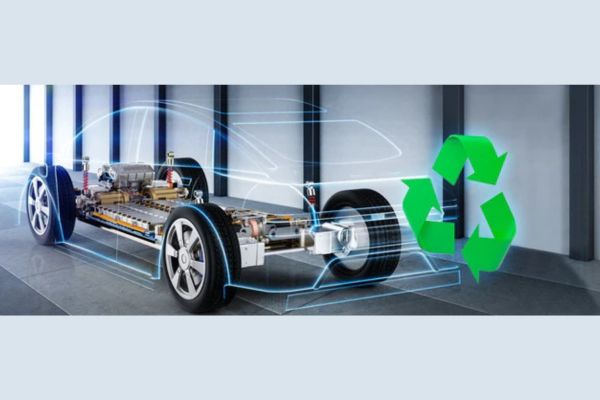Introduction
Electric Vehicles (EVs) are battery-operated, with zero emissions and are charged using electricity. They are currently in high demand in market due to various factors such as rising fuel costs, environmental concerns and affordability.
For instance, Electric Farm Tractor is used for farming operations. Unlike the traditional tractor, it does not emit any harmful gases, keeping the environment pollution-free.
EV Battery configuration
EV batteries in a Battery Management System (BMS) are made primarily from lithium ion, which are rechargeable, with long life span and low discharging rate. It ensures safety by preventing overcharging and overheating of the battery. With advancements in renewable energy solutions, the demand for lithium ion batteries has increased. However, disposal of batteries is a concern since it creates e-waste and could be hazardous to the environment, contaminating soil and water. Hence, it becomes necessary to recycle the batteries.
EV Battery Recycling
Electric Vehicles Battery Recycling refers to the extraction of valuable materials such as lithium, aluminum, cobalt, and nickel from the battery and creating new batteries out of them. At first, the condition of the battery is checked, and accordingly it is sent to the recycling unit.
It involves the following steps:
- Disassembly of the parts and components of the battery.
- Preprocessing, necessary for the separation of various parts.
- Extraction of valuable materials, that is to be recycled.
- Recycling the materials.
Need for sustainability
Sustainability refers to the utilization of resources in the present while ensuring they are preserved in the future for the coming generation. However, looking at the current scenario, with the increase in population and vehicle purchases, the need for fossil fuels has increased. There is more demand and less availability, leading to its high costs. This resulted in a significant shift towards electric vehicles. In addition to private vehicles, public transport systems, including buses and trains, are also shifting towards battery-operated engines. Renewable resources such as solar and wind are used to charge the vehicles, reducing the overall carbon footprint. This has reduced environmental pollution, further fulfilling sustainability goals.
Closing the Loop for EV Sustainability
Closing the Loop refers to the formation of a lifecycle, where the life of one battery ends, the valuable materials are extracted from it, and reused or recycled to manufacture new batteries or other related products. Multiple recycling units across the globe have started incorporating these techniques. This cycle continues as long as metal components composed of lithium, cobalt, nickel, and other materials can be reused to produce new batteries.
Although there are fewer recycling units for batteries, in the long run, as people become aware of their significance, it will lead to efficient use of such metals, leading to environmental sustainability.
Investing in research and development will lead to innovative ways of recycling batteries, ensuring safe disposal at the end, without causing any harm to the environment.
The initiatives taken by the government regarding the recycling of batteries have paved the path towards sustainability. By taking into consideration the budget, analyzing the risks associated with this process, and documenting proper rules and regulations, policies can be formed accordingly.
Limitations
Although recycling of battery is necessary, there are certain limitations to it.
- High Upfront Costs: The technology and infrastructure used in recycling needs skilled labor, which leads to higher upfront costs.
- Complexity: The process of extracting lithium from the battery is complex and time-consuming.
- Safety Concerns: The extraction of materials involves disassembling the parts and components, which is risky, making safety precautions mandatory.
- Economic factors: Fluctuations in the rate of raw materials lead to a change in the cost of the entire product.
- Infrastructure: An Increased number of retired EV batteries requires more recycling units. Currently, there are very few of them, leading to a slowed-down process of recycling.
Conclusion
The use of EVs and the recycling of EV batteries have significantly reduced environmental pollution, leading to the sustainability of resources. However, there is a need for awareness among people about the importance of recycling batteries. The government is introducing new policies regarding this, which will be beneficial not just for the people but also for a sustained future.
Although there are certain limitations to the recycling of batteries, adaptation to the new technology can be achieved by arranging training sessions for people in the recycling unit, under the guidance of an expert.
In conclusion, the EVs have captured the automobile market, and the batteries are being recycled for new production.

















